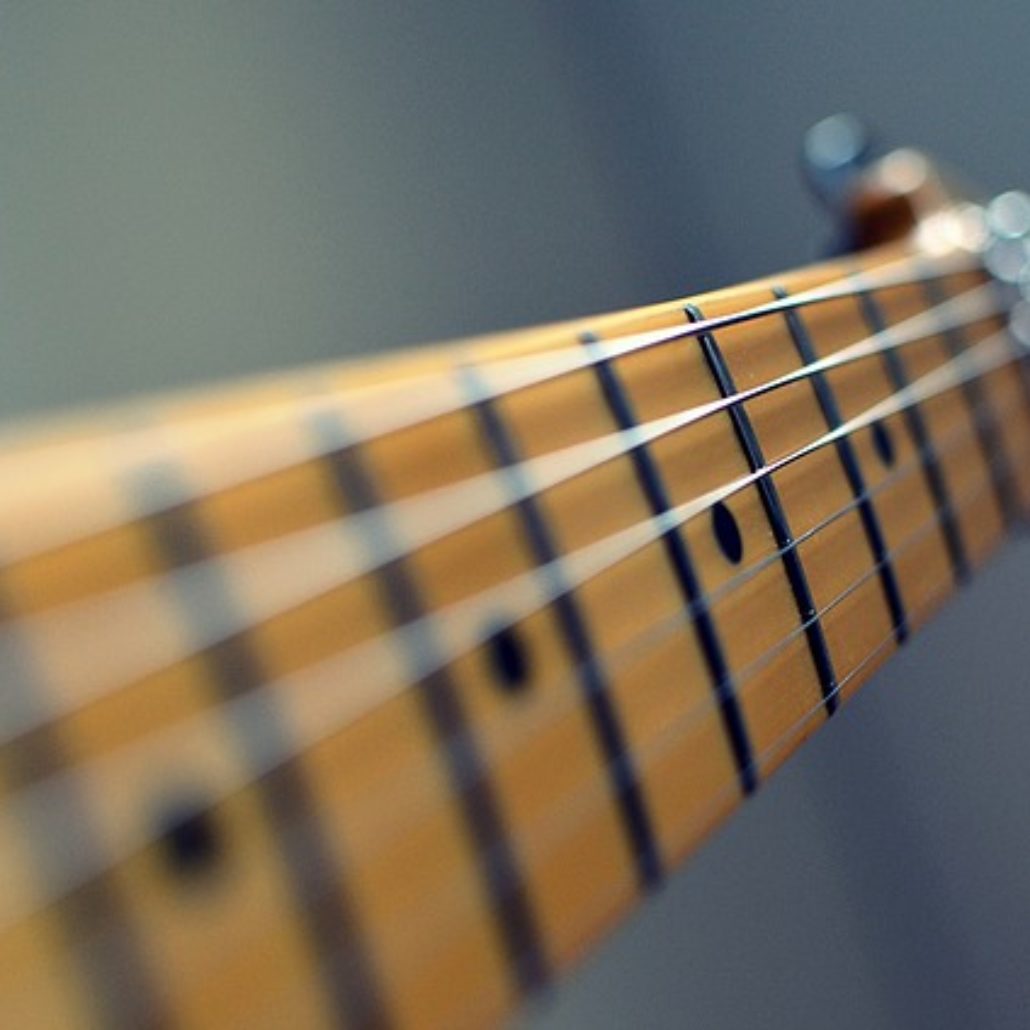General considerations
Each string company has their own way of delivering information to you regarding the tonal characteristics of their strings. These graphs, spreadsheets and infographics are most certainly helpful. They will aid you in choosing the strings that fit your play style, the EQ you need, and other considerations such as durability requirements you may have.
A final word on this: though very helpful, I find this gets me into the ballpark, but I still need to do my own research. However, I’ll also say that I may be the world’s pickiest guitar player when it comes to strings, so always take that with a grain of salt. I’m going to give you my personal opinions along with as much objectivity as I can muster. That said, I encourage you to try as many different guitar strings as you can.
How is a guitar string made?
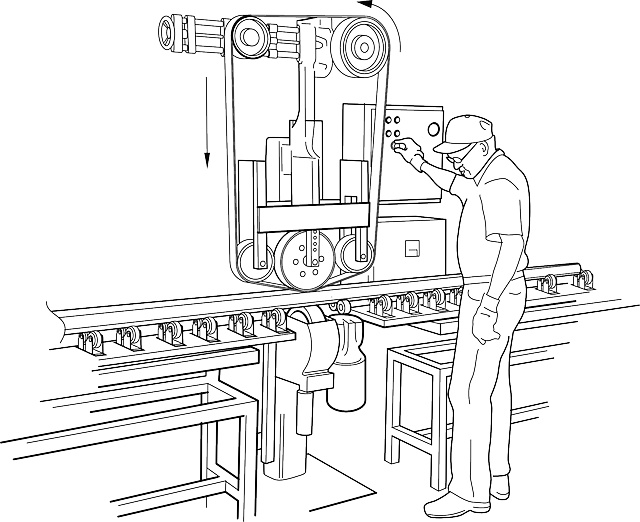
First, let’s discuss the construction of your standard electric guitar string. It all begins with a core, generally a steel core. This core can be either round or hex. The core is then wrapped with a wire made of varying materials. Pure nickel, nickel-plated steel, titanium, cobalt, stainless steel, and aluminum can be used to wrap the core.
Round core vs. Hex core
The most traditional method of string core construction, round cores have pros and cons. For example, since they are round, they allow for the entire winding to touch the surface of the core. This is hypothesized to create the most contact between the strings and frets, thereby possibly increasing sustain and resonance.
However, there are also some detractors. For example, due to its round nature, the winding sometimes slips around the core, thereby losing its connection when used in conjunction with a round wound style of string winding. This can lead to premature string breakage.
Hex cores mitigate this effect by their multi-sided approach to core construction. The edges tend to grip the winding better, thus keeping the winding from slipping. However, some speculate that hex cores lose some of the connection with the winding, thereby lowering sustain and resonance. Personally, I’m not convinced that the effects are enough to dissuade me from using hex cores as I’ve used them with generally positive results.
Let’s talk about uncoated guitar strings
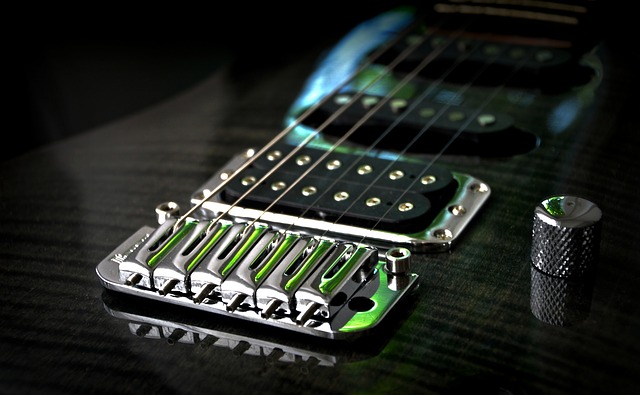
Uncoated steel strings have been around quite a long time. Since the creation of the electric guitar in 1931, which steel strings players used has been a question. The first electric guitar strings were not coated and remained this way for nearly 60 years.
Non-coated electric guitar strings have a few things going for them. They can be very affordable, produce an uninhibited tone with ample sustain and resonance, and provide plenty of connection between the player’s fingers and the string, so as to allow for easy bending.
One caveat is with flat wound strings. They are designed so that your fingers don’t make as many noises when you slide across the string. Additionally, they tend to be produced with a more mellow EQ in mind, as jazz players tend to use them and often prefer a warmer tone than players from genres such as rock or country. Rock and country players tend to spring for brighter sounding strings (especially lead players).
The roundup
I’ve always preferred uncoated strings to coated strings. They feel more organic and, though some call me crazy, I’ve often felt that since there was absolutely no coating between them and the frets, that they could better translate the vibrations between the strings and the wood.
Yes, I know that the vibrations between the fret/nut and the bridge are all that matter on an electric guitar, but I do feel vibration a bit more when I am pressing against a fret with an uncoated string. However, your mileage may vary.
What about coated electric guitar strings?

Umm…not THAT kind of coating…
Coated strings are the new kids on the block. The most popular coated electric guitar strings were first released by Elixir in 1997. It was a great year for music in general, but also specifically for guitar playing. The coating on the strings can be an enamel, or polymer coating (often a Teflon coating). Thanks to new innovations, the types of coatings are changing often.
Coated guitar strings are a wonderful addition to the guitarist’s bag of tricks. They generally do extend the life of your strings. Sometimes by up to 5 times the normal length of an uncoated string. However, there are other times where I’ve personally experienced a coated electric guitar string fail after less than a month.
Controversial
Coated strings are like any other hot topic in the guitar industry: touchy. I really mean that. Not only do they have a different feel than uncoated strings, but they have a different feel from product line to product line and from brand to brand. In fact, there are only two constants to mention universally across all coated string lines: they are generally “slicker” than uncoated strings, and they all tend to “flake” when they’ve been used sufficiently.
These types of electric guitar strings have their pros. First, they last a long time. Second, they protect your strings from sweat, dirt, grime, gunk buildup, and bodily reactions to metals. For example, if your body chemistry tends to be very acidic and the acid is released through your sweat, it will not affect your strings thanks to the coating.
Additionally, the “slick” feel most of them possess can help with finger slides, hammer-ons, and pull-offs. Depending on your style, you may prefer this. Also, due to their longer life span, they could theoretically be budget friendly. This will depend on how long they last before they “go dead” and become dull.
Like any good argument starter, they have their cons. Coated electric guitar strings tend to be 2-5x more expensive than the price of uncoated strings. Additionally, the “slick” feel can also be a negative. Some players report trouble with bending their strings because of this.
After I’ve played them dull, I notice the coating will start flaking off. Needless to say, this neither looks pleasant, nor feels good under my fingers. Finally, I do feel the resonance and tone of the strings are changed, if ever so slightly.
The roundup
Coated strings tend to be the compression pedal of strings for me. They don’t start out as vibrant as an uncoated string, but they keep their status of “good string” longer than uncoated guitar strings. If you hate string changes and play as a hobbyist or beginner for 30 minutes each day, these strings may last you 3-6 months per set.
If you’re playing so much guitar you forget to eat, these strings will still last longer, but will annoy you after a week because you’ll notice the physical signs of use, such as the flaking effect the polymers can have.
Should I use flat wound or round wound strings?
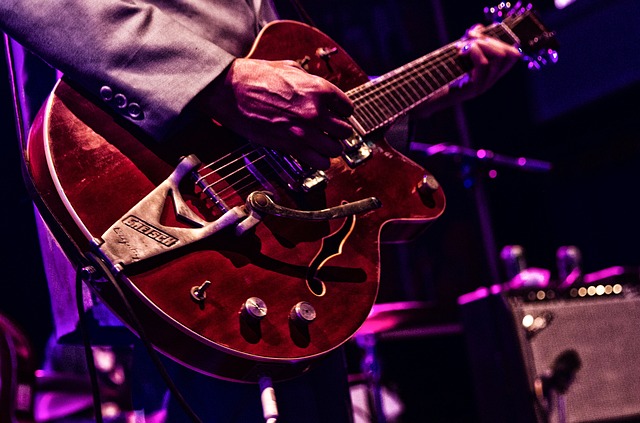
Flat wounds are the answer for players who want smooth, warm tone, with minimal detection of fingers sliding against the strings, but don’t want to use coated strings. In general, I find flat wound strings to be wonderfully sensitive and pleasantly soft both in tone and playability.
Additionally, due to being flat wound, I am able to slide easily up and down the strings with my fingers. Flat wound guitar strings still find windings on the three low strings (and often on the 4th, depending on the brand you get), but these windings do not protrude as much as round wound strings.
For this reason, I find that different genres gravitate toward and away from round wounds. For example: jazz, finger-style, and funk music players tend to pick flat wounds. Though alternative rock bands can be found playing flat wound strings, fewer rock, country and blues players make flat wounds their go-to string choice.
Longer life span for your guitar strings
Flat wound strings are constructed so that there is very little spacing or gap between the winding coils of the strings. This means that like coated strings, less dirt and grime can stick into crevasses, thus increasing the life span of your strings. This is nice because flat wounds can cost 1.5-2x more than standard uncoated round wound strings.
A few cons to flat wounds are in order. First, as we’ve previously discussed, they tend to be more expensive than your standard uncoated string. Second, I find them marginally tougher to bend large distances/pitches. I say marginally as a professional player.
If you are a beginner, you can expect this difficulty to be exaggerated slightly. A good description of this characteristic is that I find myself having to consciously pre-plan bigger bends of a whole step or more.
The roundup
Honestly? I love flat wounds. They’re very good for the style of music I routinely play (a fusion of funk, jazz, rock, finger-style and country). They also do a good job of tonally balancing particularly bright guitars. For example, I have a telecaster that benefits greatly from the warmth provided by flat wound strings.
However, be aware that they don’t have that signature “bite” to them that chicken pickers, or rockers may be looking for. Still, these strings are worth a try at least once.
What are half-round/semi-flat wound electric guitar strings?

These strings are the love-child of flat wound and round wound strings. The most popular methods for their construction are using over sized winding around the string core so that the winding can be ground/milled or pressed flatter.
Half-wound strings retain some of their round core brightness but acquire flat wound noiseless properties and increased comfort when executing slides between your strings and fingers. Additionally, they do benefit from having less spacing between winding coils, similar to flat wounds.
They still suffer from similar string bending issues that flat wounds do, but they aren’t quite as warm and mellow as flat wounds. Generally speaking, they are the mid-range to the round wound’s high-range EQ and the flat wound’s low-range. It should be noted that these descriptions will in no way drastically change your amplifier’s EQ, but it may require you to tweak it a little.
A passing negative is the fact that half/semi-flat wounds tend to be marginally more expensive than standard uncoated round wound strings but won’t break the bank any time soon.
The roundup
Half/Semi-flat wound strings are a very cool idea and as a player who finds himself covering a lot of genres regularly, they are a welcome addition to the string arsenal. Highly versatile, half/semi-flat wound strings are something every player should try.
Which string gauge should I use?
Here’s a quick table for everyone so you can easily identify which string gauge you are using:
Extra/Ultra Light: .008-.038/40
Super Light: .009-42
Regular/Regular Light: .010-.046
Medium: .011-.049
Jazz Light: .012-.052
Jazz Medium: .013-.056
Arguably one of the most important questions you could ask, the string gauge you put on your instrument will determine the size of the string (that’s literally what the gauge ratings mean), and how much tension you feel when pressing on or bending the guitar strings. Let’s go through a few general factors to help you out.
Fender-scale guitars
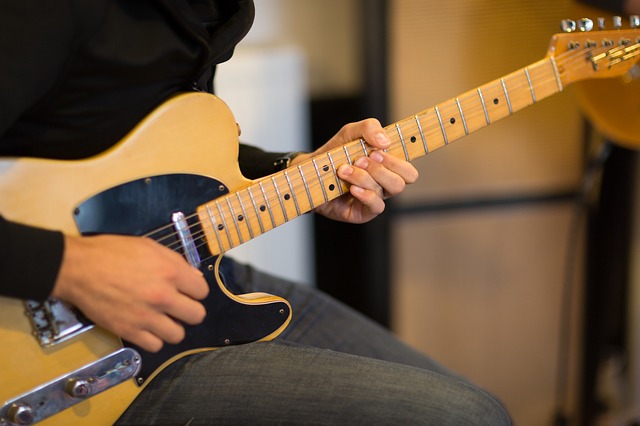
Fender guitars such as Stratocasters and Telecasters come with factory installed 9’s or .009-.042 gauge electric guitar strings. The scale length of Fender guitars are 25.5” (this means it is 25.5” from the nut to the bridge/saddle). I find that this makes for a low-tension but snappy string experience. It’s one of my preferred “feels” when it comes to electric guitar strings.
Gibson-scale guitars
Gibson guitars have historically come from the factory with 10’s or .010-.046 gauge electric guitar strings. The tension on these guitars is only a little heavier than Fender because Gibsons, and many guitars of this style, are 24.75” scale instruments (which means it measures 24.75” from nut to bridge/saddle). These are instruments such as Les Pauls and SGs.
These are the most popular string gauges and what many guitars come set up with. However, there are other string gauges worth noting. In heavy metal and jazz, 11’s or .011-.049 gauge electric guitar string sets are popular.
With jazz, it’s because there is more natural sustain and resonance. For heavy metal music, it’s due to the fact that the string tension is higher and therefore, the strings don’t lose too much tension when the metal players drop tune their instruments (as they often enjoy doing).
Another genre that enjoys this gauge is finger-style, ala Chet Atkins and Jerry Reed. A point of distinction though: finger-style and jazz players tend to use flat-wound strings.
Heavy-gauge guitar strings

Still heavier are .012-.052, or 12’s. This gauge is used by jazz, metal and finger-style players as well for the aforementioned reasons.
Next up we have .013-.056, or 13’s. These are the big boys for me, but are still considered “jazz mediums”. This tension is far outside my normal purview. These are very heavy for me, but they have amazing resonance and sustain. A fun side note, it is rumored that Stevie Ray Vaughan used 12’s and 13’s throughout his career to get the heavy yet articulate sound for his raucous style of blues.
Some players go lighter. For example, it is rumored that late in his career, Eric Clapton began playing with .008-.038, or 8’s. This produces a very loose tension even on 25.5” scale length electric guitars. It makes for very easy bending on your instrument.
“Custom” string gauges
You may see gauges called “heavy bottoms” or “hybrid” string gauges as well as things like “balanced tension” string gauge sets. These are string gauge sets that take certain strings from one set and certain strings from other sets and combine them. For example, “heavy bottom” string gauge sets may use the high E, B, and G from a .009 gauge set and the D, A, and low E of a .010 gauge set so that your “chunking” in rock and metal sounds heavier.
In “balanced tension” string sets, there will be several strings from the regular gauge composition, but there will be others that are lower or higher in gauge so that the same string tension can be felt across all strings when bending or sliding. I find these sets to do exactly what they describe. In most sets that I’ve used, it requires a more uniform pick attack and allows me to more easily bend the heavier, lower pitched strings.
Different string gauges require different setups
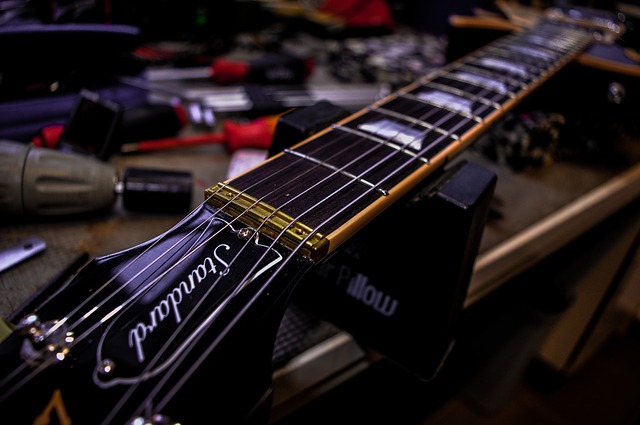
This is important: If you are changing string gauges at all, technically your instrument will require a new setup to help it function optimally. This can include everything from simple truss rod adjustments to newly cut nuts, re-intonation at the bridge, and string height adjustments. But there are string gauge changes you can “get away with”.
For example: .009 gauges sets to .010 gauge sets are doable. I rock out on .0095, or 9.5 gauge sets and switching from either .009s or .010s to .0095s is simple. Basically, from one gauge to any string set ONE gauge higher or lower will work, but it will need a slight tweak of the truss rod. Always remember, it STILL needs a full setup to function optimally. I use this method to try different gauges from time to time.
Helpful tips
Buy in 3 packs if you can. It’s the only way to get an average on how the strings operate on your guitars, and their sonic characteristics. Using one set won’t do it. Also, once you find your preferred string, I encourage you to also buy in bulk. If you’re like me, you’ll save a boat load of money that way.
Now that we’ve discussed some of the questions and choices when buying electric guitar strings, here are a few suggestions for your consideration. Remember that there are far more brands and types of electric guitar strings than what are represented here, but these are generally great options for folks who are looking to freshen up their sound.
Ernie Ball Slinkys
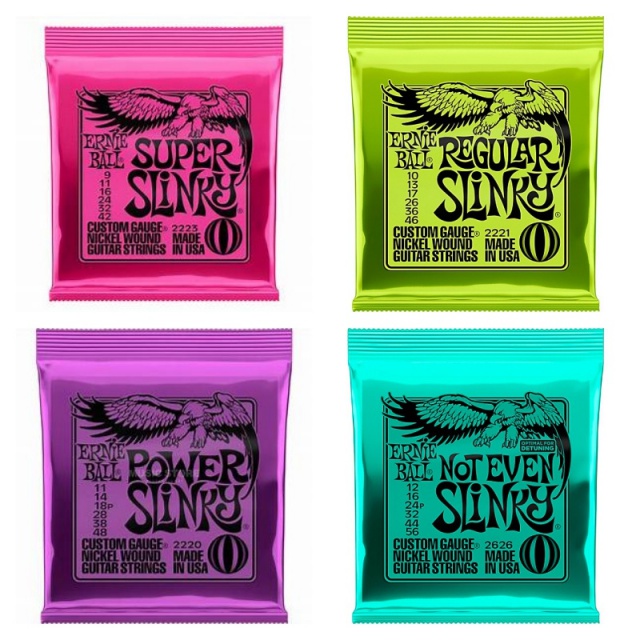
Arguably one the most popular string brands on the market, Ernie Ball Slinky electric guitar strings are solid, time-tested products. They work well on most guitars and all that’s left is to decide which gauge and whether or not you want a “custom” set.
Regular Slinkys are the standard string gauge offerings of .010-.046, but in general, Ernie Ball Slinkys are good options no matter the string gauge. Here’s a few examples in different string gauges
Ernie Ball Super Slinky .009-.042: (3-PACK) https://www.amazon.com/Ernie-Ball-Nickel-Electric-Strings/dp/B0064RTUP4/ref=sr_1_4?ie=UTF8&qid=1539013799&sr=8-4&keywords=electric+guitar+strings+ernie+ball+.009
Ernie Ball Regular Slinky .010-.046: (3-PACK) https://www.amazon.com/Ernie-Ball-Regular-Slinky-Nickel/dp/B00CAV0TRQ/ref=sr_1_3?ie=UTF8&qid=1539013756&sr=8-3&keywords=electric+guitar+strings+ernie+ball+.010
Ernie Ball Power Slinky .011-.048: (3-PACK) https://www.amazon.com/Ernie-Ball-Slinky-Nickel-Sets-011/dp/B0064RU0W6/ref=sr_1_5?ie=UTF8&qid=1539013687&sr=8-5&keywords=electric+guitar+strings+ernie+ball+.011
Ernie Ball Not Even Slinky .012-.056: (3-PACK) https://www.amazon.com/Ernie-Ball-Guitar-Strings-Electric/dp/B00THNXD1Y/ref=sr_1_9?ie=UTF8&qid=1539013844&sr=8-9&keywords=electric+guitar+strings+ernie+ball+NOT+EVEN+SLINKY
D’Addario EXL
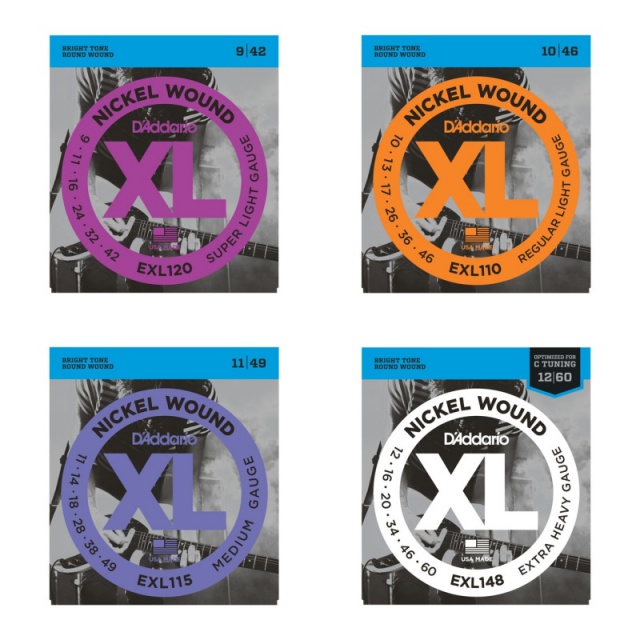
Full disclosure: D’Addario EXLs are arguably my favorite electric guitar strings. I’m being up front about this since I have a smidge of bias. These strings are bright and articulate, but not piercing. They are the quintessential nickel-plated round wounds.
I like them because for me, they perform well for country, rock, and contemporary Christian worship scenarios, which I often play. On the right guitar, they can help with a convincing jazz. I’d pair it with a Les Paul or SG style instrument for that.
Oddly enough, they can be a tad bright on a semi-hollow, but I still use them because my semi-hollow usage doesn’t solely consist of jazz or finger style. To acquire that tone, I simply roll the tone knob back or work it out via EQ on my amplifier.
D’Addario EXL .009-.042: (3-PACK) https://www.amazon.com/DAddario-EXL120-3D-Nickel-Electric-Strings/dp/B000CC4JFS/ref=sr_1_1?ie=UTF8&qid=1539014135&sr=8-1&keywords=electric+guitar+strings+d%27addario+.009
D’Addario EXL .010-.046: (3-PACK) https://www.amazon.com/DAddario-EXL110-3D-Electric-Strings-Regular/dp/B000EEJ91I/ref=sr_1_3?ie=UTF8&qid=1539032783&sr=8-3&keywords=electric+guitar+strings+d%27addario+.010
D’Addario EXL .011-.049: (3-PACK) https://www.amazon.com/DAddario-EXL115-3D-Electric-Strings-Blues-Jazz/dp/B000HP0ND2/ref=sr_1_2?ie=UTF8&qid=1539032861&sr=8-2&keywords=electric+guitar+strings+d%27addario+.011
D’Addario EXL .012-.060: (SINGLE SET) https://www.amazon.com/DAddario-EXL148-Electric-Strings-Extra-Heavy/dp/B0037M872Q/ref=sr_1_3?ie=UTF8&qid=1539033003&sr=8-3&keywords=electric+guitar+strings+d%27addario+.012
GHS Boomers
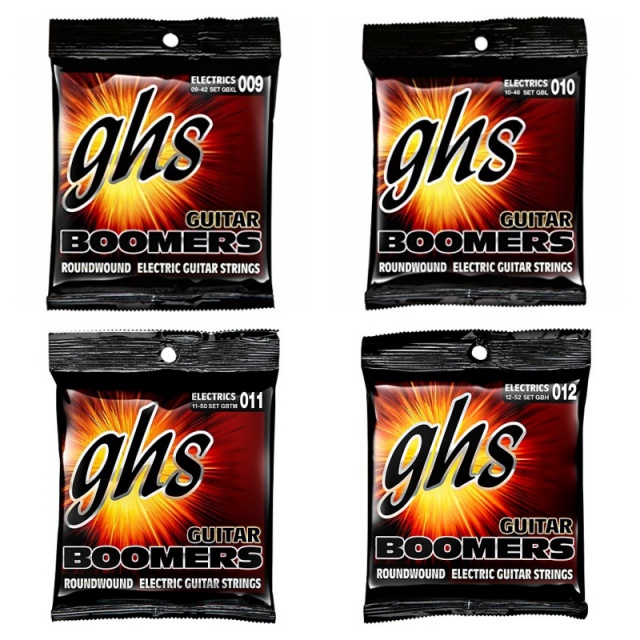
These strings have a powerful reputation. They’re uncoated nickel wound strings that produce a strong, bright sound that commands attention. They’re also individually packaged and sealed which is guaranteed to give you fresh strings even if you simply need to change a single string on your instrument.
To be clear, if you buy a set, you get all 6 strings, but each string is packed in its own “Nitro Pack” individual packaging inside of the outer shell packaging. These individual packs are air-tight and filled with nitrogen to ensure that you receive the freshest possible string. The shelf life is therefore substantially longer than you’d expect and longer than many other strings on the market.
GHS Boomers .009-.042: (SINGLE SET) https://www.amazon.com/Boomers-Extra-Light-Electric-Strings-9-42/dp/B0002CZUF6/ref=sr_1_12?ie=UTF8&qid=1539053867&sr=8-12&keywords=ghs+boomers+9-42
GHS Boomers .010-.046: (SINGLE SET) https://www.amazon.com/Guitar-Boomers-Electric-GBL-10-46/dp/B0002CZUD8/ref=sr_1_9?ie=UTF8&qid=1539053736&sr=8-9&keywords=ghs+boomers+10-46
GHS Boomers .011-.050: (SINGLE SET) https://www.amazon.com/GHS-Strings-GBM-Nickel-Plated-011-050/dp/B0002CZUDS/ref=sr_1_3?ie=UTF8&qid=1539053621&sr=8-3&keywords=ghs+boomers+.011
GHS Boomers .012-.052: (SINGLE SET) https://www.amazon.com/GBH-Boomers-Electric-Guitar-Strings/dp/B0009FCD0Q/ref=sr_1_3?ie=UTF8&qid=1539053807&sr=8-3&keywords=ghs+boomers+12
Flat wound electric guitar strings
D’Addario Chromes
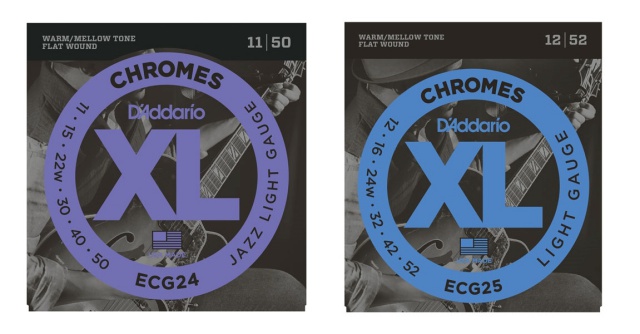
These strings are “ribbon” wound, as the manufacturer says, and they help produce an ultra-smooth feel and warm, silky tone. Chromes are used by players across the world and come in a corrosion resistant packaging to help keep them fresh.
For those looking for American quality and craftsmanship, these strings are made in the USA. I really enjoy these strings for how easy they make my slides. I don’t have to worry about getting caught at any time, I just glide to my next note. You may find yourself not wanting to go back to roundwound strings.
D’Addario Chromes Jazz Light .011-.050: (SINGLE SET) https://www.amazon.com/DAddario-Guitar-Strings-Chromes-Light/dp/B000EEL5X8/ref=sr_1_3?ie=UTF8&qid=1539053981&sr=8-3&keywords=d%27addario+flatwound+electric+guitar+strings
D’Addario Chromes Light .012-.052: (SINGLE SET) https://www.amazon.com/DAddario-ECG25-Chromes-Electric-Strings/dp/B0007WOX22/ref=sr_1_1?ie=UTF8&qid=1539054680&sr=8-1&keywords=d%27addario+flatwound+electric+guitar+strings+.012
Coated electric guitar strings
Elixir Electric guitar strings: Nanoweb vs. Polyweb vs. Optiweb

And here we are, at the center of the coated electric guitar string debate: Elixir strings. There are three coating options for Elixir strings: Nanoweb, Polyweb, and Optiweb.
Polyweb is the original coating. It produces a warm, mellow, and fat tone. I wouldn’t say it’s dark though. There’s still enough high end to notice its presence. These strings pair well with hollow and semi-hollow body guitars in that their tone stays warm and tight but allows for easy movement of the strings through setups like a Bigsby tremolo.
Nanoweb is Elixir’s second chronological offering, but as the name suggests, the coating is thin. It’s a much brighter tone than its predecessor in that there’s definitely some noticeable bite to them. I’d say that Nanoweb is a good choice for country, rock, spanky funk, blues, and metal, as you can more easily cut through a mix with the natural EQ of these strings.
Optiwebs are the new kid on the block, relatively speaking. This is the thinnest coating offered by Elixir. They were designed to be the closest thing to an uncoated electric guitar string, while still retaining longer life-span.
If you want a coated string with bite and a feel for the nickel-plated round wound string so you can grip it like an uncoated version, this is the one for you. However, just remember that with thinner coatings come more noise and brighter EQs. These are great for country, dirty blues, and rock.
Elixir Polyweb .009-.042: (SINGLE SET) https://www.amazon.com/Elixir-Strings-Electric-POLYWEB-009-042/dp/B0002FO9EG/ref=sr_1_3?ie=UTF8&qid=1539033162&sr=8-3&keywords=electric+guitar+strings+elixir+.009
Elixir Nanoweb .009-.042: (SINGLE SET) https://www.amazon.com/Elixir-Strings-Electric-NANOWEB-009-046/dp/B0002E1O40/ref=sr_1_4?ie=UTF8&qid=1539033162&sr=8-4&keywords=electric+guitar+strings+elixir+.009
Elixir Optiweb Custom Light .009-.046: (SINGLE SET) https://www.amazon.com/Elixir-Strings-19027-Electric-009-046/dp/B01NBNS2OA/ref=sr_1_1?ie=UTF8&qid=1539033805&sr=8-1&keywords=electric+guitar+strings+elixir+.009+optiweb
Elixir Polyweb .010-.046: (SINGLE SET) https://www.amazon.com/Elixir-Strings-Electric-POLYWEB-010-046/dp/B0002E1NQE/ref=sr_1_1?ie=UTF8&qid=1539033959&sr=8-1&keywords=elixir+polyweb+electric+guitar+strings
Elixir Nanoweb .010-.046: (SINGLE SET) https://www.amazon.com/Elixir-Strings-Electric-NANOWEB-010-046/dp/B0002E1O3G/ref=sr_1_8?ie=UTF8&qid=1539033959&sr=8-8&keywords=elixir+polyweb+electric+guitar+strings
Elixir Optiweb .010-.046: (SINGLE SET) https://www.amazon.com/Elixir-Strings-19052-Electric-010-046/dp/B01MQZ62XV/ref=sr_1_1?ie=UTF8&qid=1539034178&sr=8-1&keywords=elixir+polyweb+electric+guitar+strings+optiweb
Elixir Nanoweb .011-.049: (SINGLE SET) https://www.amazon.com/Elixir-Strings-Electric-NANOWEB-011-049/dp/B0002E1O5E/ref=sr_1_fkmr1_2?ie=UTF8&qid=1539034338&sr=8-2-fkmr1&keywords=elixir+electric+guitar+strings+.011+polyweb
Elixir Optiweb .011-.049: (SINGLE SET) https://www.amazon.com/Elixir-Strings-19102-Electric-011-049/dp/B01N4H4N2L/ref=sr_1_4?ie=UTF8&qid=1539034507&sr=8-4&keywords=elixir+electric+guitar+strings+.011
Final thoughts
The electric guitar strings I’ve listed here are only a few of the offerings out there. I’ll have another article featuring some more options for you all later, if it’s not up already. Remember, I recommend trying out as many string brands and types as you can so you can truly find your sound. Thanks for reading, and have a great day!
